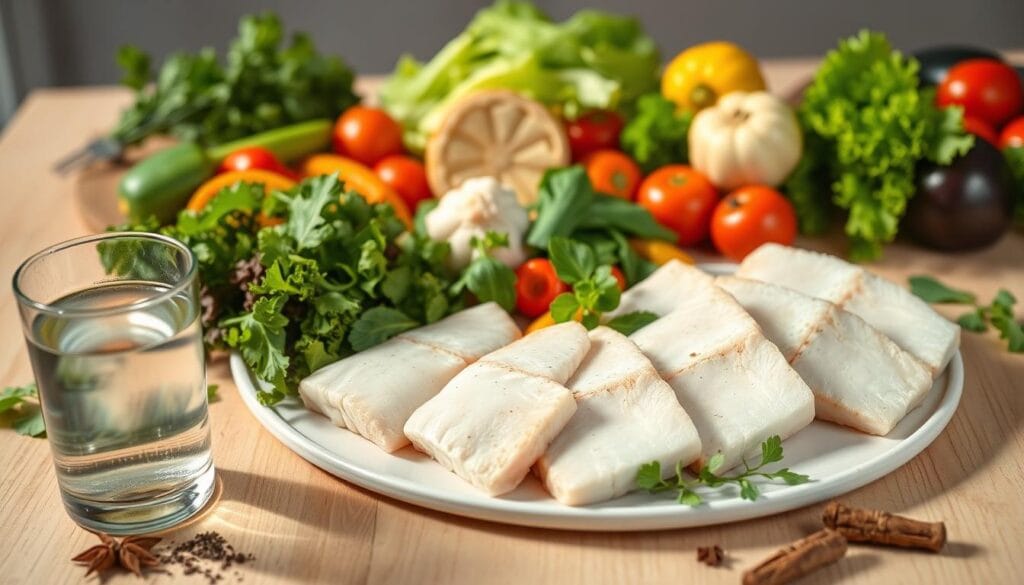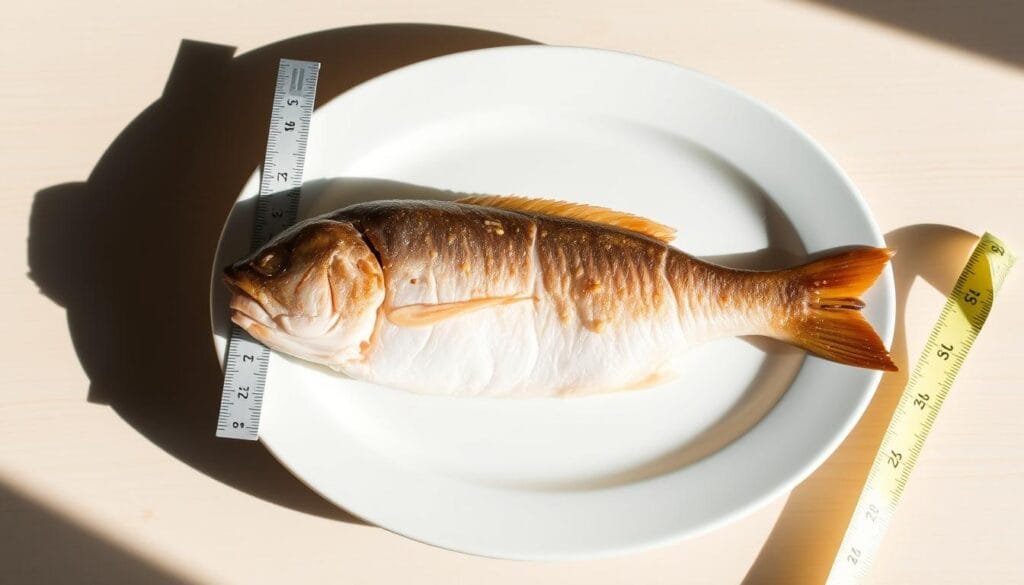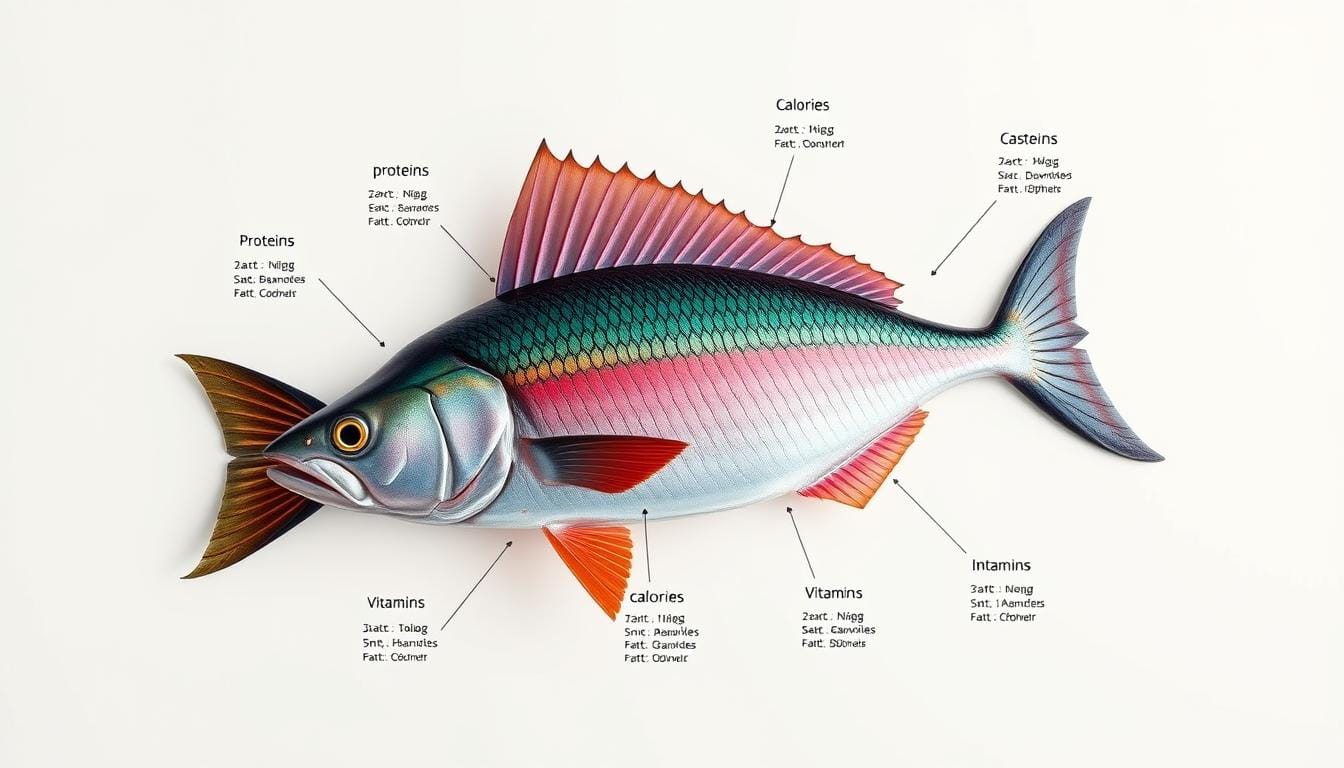Every seafood lover remembers that perfect fish dish that changed their perspective on healthy eating. For me, discovering mahi mahi was a culinary revelation. It transformed my approach to nutrition. This vibrant tropical fish isn’t just a delicious meal—it’s a powerhouse of health benefits.
Table of Contents
Mahi mahi calories are surprisingly lean, making it an exceptional choice for anyone seeking a nutritious protein source. One cup of grilled mahi mahi delivers an impressive nutritional profile. It can support your wellness goals. Whether you’re an athlete, a health-conscious individual, or simply someone who loves flavorful seafood, understanding mahi mahi nutrition can be a game-changer for your meal planning.
This comprehensive guide will explore the incredible world of mahi mahi. We’ll break down its nutritional secrets and reveal why this fish deserves a prominent place on your plate. Get ready to dive deep into a sea of nutritional insights that will transform how you think about seafood.
Key Takeaways
- Mahi mahi offers exceptional protein with minimal calories
- Low in fat and high in essential nutrients
- Versatile fish suitable for multiple dietary approaches
- Supports muscle development and overall health
- Easy to prepare with multiple cooking techniques
Understanding Mahi Mahi: A Tropical Delicacy
Dive into the world of mahi mahi, a vibrant and delicious fish. It offers many health benefits. This tropical seafood marvel has won the hearts of chefs and health enthusiasts worldwide.
Origin and Species Information
Mahi mahi, scientifically known as Coryphaena hippurus, thrives in warm ocean waters. It’s found in Hawaii, the Caribbean, and the Gulf of Mexico. Fishermen love it for its unique look and taste.
The name “mahi mahi” comes from Hawaiian. It means “strong strong,” showing the fish’s powerful swimming.
- Native to tropical and subtropical waters
- Part of the dolphinfish family
- Known for rapid growth and short lifespan
Physical Characteristics
Mahi mahi is known for its stunning features. It has brilliant colors that change quickly. You’ll see vibrant greens, blues, and yellows.
Adult mahi mahi can grow up to 6 feet long. They’re an impressive catch for marine enthusiasts.
Culinary Popularity
Chefs and home cooks love mahi mahi for its firm, flaky texture and mild flavor. It’s versatile, great for grilling, baking, or pan-searing. Its health benefits and taste make it a favorite in restaurants.
“Mahi mahi represents the perfect blend of nutrition and flavor in seafood cuisine.” – Culinary Expert
Whether you love seafood or want to add nutritious proteins to your diet, mahi mahi is exciting. It offers a great taste and health benefits.
Mahi Mahi Calories and Macronutrient Breakdown
Learning about mahi mahi calories and nutrition helps you choose better food. One cup of mahi mahi (about 238 grams) is packed with nutrients. It supports your health and fitness goals.
Mahi mahi is a lean protein powerhouse. Here’s what you get in one serving:
- Approximately 202 calories
- 44 grams of high-quality protein
- 2.4 grams of fat
- Zero carbohydrates
This unique mix of macronutrients makes mahi mahi great for those looking for a protein-rich food. It’s low in calories but high in protein. This helps keep muscles strong and aids in weight management.
| Nutrient | Amount per Cup | Percentage of Daily Value |
|---|---|---|
| Calories | 202 | 10% |
| Protein | 44g | 88% |
| Fat | 2.4g | 3% |
| Carbohydrates | 0g | 0% |
Pro tip: The zero-carb profile of mahi mahi makes it an ideal protein source for low-carbohydrate and ketogenic diets.
“Mahi mahi offers a nutritional profile that supports both fitness enthusiasts and health-conscious individuals.” – Nutrition Experts
Essential Nutrients in Mahi Mahi
Mahi mahi is a nutritional powerhouse. It’s packed with vitamins, minerals, and compounds that boost your health. This tropical fish is not just tasty; it’s also a treasure for your body.
Vitamins and Mineral Breakdown
Mahi mahi is more than just protein. It’s full of essential vitamins and minerals that help your body work right:
- Vitamin B6: Supports brain health and metabolism
- Vitamin B12: Crucial for nerve function and red blood cell formation
- Selenium: Powerful antioxidant that protects cell health
- Potassium: Helps regulate heart and muscle function
Omega-3 Fatty Acid Content
The mahi mahi is rich in omega-3 fatty acids. These fats are key for reducing inflammation, heart health, and brain function.
| Nutrient | Amount per 3 oz Serving | Daily Value % |
|---|---|---|
| Omega-3 Fatty Acids | 0.5 g | 10-15% |
| Protein | 20 g | 40% |
| Vitamin B12 | 2.5 mcg | 104% |
Protein Quality Analysis
Mahi mahi has an exceptional protein profile. It has all essential amino acids. This lean protein helps build muscle, manage weight, and keeps you energized all day.
“Mahi mahi is nature’s perfect protein package – lean, nutritious, and delicious!” – Nutritional Expert
Health Benefits of Including Mahi Mahi in Your Diet
Exploring mahi mahi health benefits can change how you view food. This tasty fish is packed with nutrients that boost your health. It’s full of proteins and omega-3 fatty acids, offering many benefits for your body and mind.
Mahi mahi’s benefits go beyond its great taste. Research shows it helps in many ways:
- Supports cardiovascular health
- Promotes brain function
- Reduces inflammation
- Boosts muscle development
Your heart will benefit from eating mahi mahi. The omega-3 fatty acids in it help lower heart disease risk. Studies show eating fish often can lower heart problems.
“Food is the most powerful medicine when chosen wisely” – Nutritional Research Institute
Mahi mahi also benefits your brain and eyes. Its nutrients support your brain and keep your vision sharp. It’s high in protein and low in calories, making it a great choice for a healthy diet.
Choosing mahi mahi means more than just a tasty meal. It’s an investment in your health. It helps with muscle recovery, reduces inflammation, and gives you important minerals for wellness.
Comparing Mahi Mahi to Other Fish Species
Learning about mahi mahi nutrition compared to other fish can guide your food choices. Each fish has its own nutritional benefits. Mahi mahi is special because of its rich nutrient content.
Looking at mahi mahi calories and nutrition, you’ll find it has many benefits over other seafood.
Nutritional Comparison Highlights
- Mahi mahi has low-calorie protein with about 85 calories per 100 grams
- It has less fat than salmon and other fatty fish
- It’s a lean protein source with 18.5 grams of protein per 100 grams
Caloric Density Analysis
Let’s compare mahi mahi calories to other popular fish:
| Fish Type | Calories (per 100g) | Protein (g) | Fat (g) |
|---|---|---|---|
| Mahi Mahi | 85 | 18.5 | 0.7 |
| Salmon | 175 | 20 | 10 |
| Tuna | 130 | 23 | 2.1 |
Protein-to-Fat Ratio Benefits
Mahi mahi nutrition is great because of its protein-to-fat ratio. It has very little fat and lots of high-quality protein. This makes it a top choice for those looking for lean protein.
The low calories in mahi mahi, along with its nutrient density, make it a good choice for managing weight and building muscle.
Weight Loss and Dietary Considerations

Finding the right protein for weight loss can be tough. Mahi mahi is a great choice that helps you reach your health goals. It’s low in calories but packed with nutrients.
Mahi mahi is good for weight loss because of its special nutrients. A 4-ounce serving has:
- About 100 calories
- 22 grams of quality protein
- Little saturated fat
- Nutrients that boost metabolism
Adding mahi mahi to your diet can help with weight loss. It’s high in protein, which keeps you full and cuts down on calories. It’s perfect for many diets, like keto, Mediterranean, low-carb, and high-protein.
- Keto diets
- Mediterranean nutrition plans
- Low-carbohydrate meal designs
- High-protein weight management programs
Nutritionists say eating mahi mahi 2-3 times a week helps with weight loss and keeps muscles lean. It’s also versatile, making meals exciting while staying healthy.
Choosing the right protein is key for lasting weight management.
Preparation Methods and Their Impact on Calories
Cooking mahi mahi changes its nutritional profile and calorie content. Knowing how to cook mahi mahi helps you make healthier meals. It keeps the fish’s flavor and nutrients intact.
Your cooking method greatly affects the calories in mahi mahi. Some methods add few calories, while others increase the dish’s calorie count a lot.
Grilling: A Low-Calorie Cooking Technique
Grilling mahi mahi is great for keeping calories low. It uses little oil and lets fat drip away while cooking.
- Uses minimal added fat
- Preserves natural fish flavor
- Reduces overall calorie content
Comparing Cooking Methods
| Cooking Method | Calories per 4 oz Serving | Fat Content |
|---|---|---|
| Grilled | 110-120 | Low |
| Baked | 100-115 | Low |
| Pan-Seared | 130-145 | Moderate |
| Deep-Fried | 250-300 | High |
Healthy Cooking Tips
To keep mahi mahi recipe calories low, try these tips:
- Use herbs and citrus for flavor instead of heavy sauces
- Choose non-stick cooking surfaces
- Avoid breading or battering the fish
- Use minimal oil when cooking
Pro tip: Try marinades with lemon, garlic, and herbs to add flavor without extra calories.
Selecting and Storing Fresh Mahi Mahi
Choosing the right mahi mahi is key to making tasty meals. To start, know what makes a great catch.
Here’s what to look for in fresh mahi mahi:
- Bright, translucent flesh with a slight pink or white color
- Firm texture without any soft or mushy areas
- Clean, ocean-like smell without strong fishy odors
- Shiny surface with no discoloration
Storing the fish right keeps it fresh and full of nutrients. Refrigerate it right away after buying. Use your fish within two days for the best flavor and texture.
| Storage Method | Duration | Recommended Technique |
|---|---|---|
| Refrigeration | 1-2 days | Store in airtight container on ice |
| Freezing | Up to 3 months | Wrap tightly in freezer paper or vacuum seal |
Freezing mahi mahi for later? Here’s how:
- Wrap fish tightly to prevent freezer burn
- Label with the date of freezing
- Thaw slowly in the refrigerator
- Never thaw at room temperature to prevent bacterial growth
By picking top-notch mahi mahi and storing it right, you’ll have a great seafood meal every time.
Recommended Serving Sizes and Portion Control

Knowing the right serving sizes for mahi mahi is key for a healthy diet. By controlling portions, mahi mahi becomes a great choice for those looking for a protein-rich diet.
Daily Intake Guidelines
The American Heart Association suggests eating fish at least twice a week. A standard serving of mahi mahi is about 3-4 ounces. This size usually has:
- Roughly 100-130 calories
- About 20-25 grams of protein
- Low in saturated fat
Meal Planning Tips
Here are some tips for adding mahi mahi to your meals:
- Use a food scale to measure precise portions
- Pair with low-calorie vegetables for balanced meals
- Alternate between different protein sources to maintain variety
Portion Size Visualization
A good way to control mahi mahi portions is to compare them to your hand. Your protein portion should be about the size and thickness of your hand. This ensures you get the right amount of nutrients without too many calories.
“Moderation and mindful eating are key to a healthy diet” – Nutrition Experts
Potential Mercury Content and Safety Considerations
When looking into mahi mahi health benefits, knowing about mercury levels is key. Mahi mahi is a low-mercury fish, making it a good choice for many people.
Mercury levels differ in various fish. Mahi mahi has much lower mercury than big predatory fish like shark or swordfish. This makes it safer to eat often.
- Low mercury concentration
- Safe for most dietary plans
- Recommended for frequent seafood consumers
It’s important to think about how much you eat and how often. The FDA says to limit mahi mahi to 2-3 servings a week. This helps keep mercury intake low.
Different groups have different rules:
- Adults: Up to 12 ounces weekly
- Pregnant women: Talk to your doctor
- Children: Give them smaller portions based on age
Tip: Choose fresh, responsibly caught mahi mahi. This lowers mercury risk and boosts nutritional benefits.
Always put your health first by picking high-quality seafood and following nutritional advice.
Incorporating Mahi Mahi into a Balanced Diet
Adding mahi mahi to your meals can make them both tasty and healthy. This fish is a great source of protein. It’s also low in calories, making it perfect for those watching their diet.
- Grill mahi mahi with a light citrus marinade for a zesty lunch option
- Create fish tacos using seasoned mahi mahi as a lean protein alternative
- Bake mahi mahi with Mediterranean-inspired herbs and vegetables
- Serve as a quick protein topping for summer salads
Smart Meal Combination Strategies
Pairing mahi mahi with the right ingredients boosts its nutritional value. Try combining it with:
- Quinoa for a complete protein meal
- Roasted vegetables for added fiber
- Leafy green salads to enhance nutrient absorption
- Whole grain sides for sustained energy
“Mahi mahi is like a blank canvas for culinary creativity – simple to prepare and incredibly satisfying!” – Professional Nutritionist
Weekly Meal Planning Tips
To keep your meals interesting, try different ways of cooking mahi mahi. Grill, bake, or pan-sear it to avoid getting bored. Include mahi mahi 2-3 times a week for the best health benefits.
Sustainable Fishing and Environmental Impact
Choosing sustainably sourced mahi mahi is key to protecting our oceans. It ensures this nutritious fish stays available for the future. Good fishing practices help keep our oceans diverse.
When picking mahi mahi, keep these sustainability tips in mind:
- Look for certifications from marine conservation groups
- Choose fish caught using pole-and-line or trolling methods
- Research fishing areas with strict environmental rules
- Support local fisheries that follow sustainable methods
The Natural Resources Defense Council advises being careful about seafood choices. Sustainable fishing protects marine life and gives you the best mahi mahi. This fish is full of health benefits.
| Fishing Method | Sustainability Rating | Environmental Impact |
|---|---|---|
| Pole and Line | High | Minimal ecosystem disruption |
| Longline Fishing | Low | High risk of bycatch |
| Trolling | Medium | Moderate ecosystem impact |
By making smart choices, you can enjoy tasty mahi mahi and help protect our oceans. Your buying habits affect fishing methods and ocean health.
Conclusion
Mahi mahi is a great choice for those who care about their health and want tasty protein. It has few calories but lots of health benefits. Adding this fish to your diet can boost muscle growth and overall health.
Knowing about mahi mahi’s nutrition shows it’s a lean protein with important nutrients. It’s full of omega-3s and minerals, making it a smart choice for meals. Planning your meals with mahi mahi can help you meet your dietary goals without losing flavor or nutrition.
Mahi mahi’s benefits go beyond just being nutritious. Choosing the right cooking methods and eating the right amount can make it a key part of a healthy diet. Whether you grill, bake, or pan-fry it, mahi mahi is packed with nutrients that are good for your heart, muscles, and energy.
Adding mahi mahi to your meals can be a big win for your health. By trying this tasty fish, you’ll make your diet more varied and get important health benefits.

